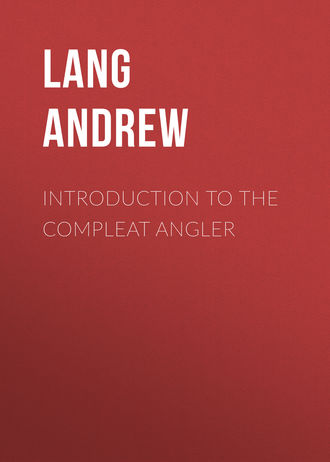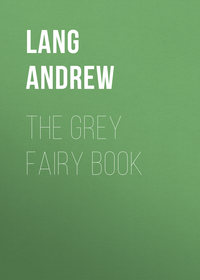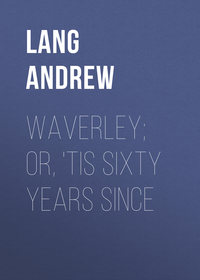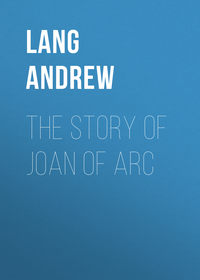 полная версия
полная версияIntroduction to the Compleat Angler
Izaak, of course, justifies us by the example of the primitive Christians, and, in the manner of the age, drowns opposition in a flood of erudition, out of place, but never pedantic; futile, yet diverting; erroneous, but not dull.
‘God is said to have spoken to a fish, but never to a beast.’ There is a modern Greek phrase, ‘By the first word of God, and the second of the fish.’ As for angling, ‘it is somewhat like poetry: men are to be born so’; and many are born to be both rhymers and anglers. But, unlike many poets, the angler resembles ‘the Adonis, or Darling of the Sea, so called because it is a loving and innocent fish,’ and a peaceful; ‘and truly, I think most anglers are so disposed to most of mankind.’
Our Saviour’s peculiar affection for fishermen is, of course, a powerful argument. And it is certain that Peter, James, and John made converts among the twelve, for ‘the greater number of them were found together, fishing, by Jesus after His Resurrection.’ That Amos was ‘a good-natured, plain fisherman,’ only Walton had faith enough to believe. He fixes gladly on mentions of hooks in the Bible, omitting Homer, and that excellent Theocritean dialogue of the two old anglers and the fish of gold, which would have delighted Izaak, had he known it; but he was no great scholar. ‘And let me tell you that in the Scripture, angling is always taken in the best sense,’ though Izaak does not dwell on Tobias’s enormous capture. So he ends with commendations of angling by Wotton, and Davors (Dennys, more probably) author of The Secrets of Angling (1613). To these we may add Wordsworth, Thomson, Scott, Hogg, Stoddart, and many minor poets who loved the music of the reel.
Izaak next illustrates his idea of becoming mirth, which excludes ‘Scripture jests and lascivious jests,’ both of them highly distasteful to anglers. Then he comes to practice, beginning with chub, for which I have never angled, but have taken them by misadventure, with a salmon fly. Thence we proceed to trout, and to the charming scene of the milkmaid and her songs by Raleigh and Marlowe, ‘I think much better than the strong lines that are now in fashion in this critical age,’ for Walton, we have said, was the last of the Elizabethans and the new times were all for Waller and Dryden. ‘Chevy Chace’ and ‘Johnny Armstrong’ were dear to Walton as to Scott, but through a century these old favourites were to be neglected, save by Mr. Pepys and Addison. Indeed, there is no more curious proof of the great unhappy change then coming to make poetry a mechanic art, than the circumstance that Walton is much nearer to us, in his likings, than to the men between 1670 and 1770. Gay was to sing of angling, but in ‘the strong lines that are now in fashion.’ All this while Piscator has been angling with worm and minnow to no purpose, though he picks up ‘a trout will fill six reasonable bellies’ in the evening. So we leave them, after their ale, in fresh sheets that smell of lavender.’ Izaak’s practical advice is not of much worth; we read him rather for sentences like this: ‘I’ll tell you, scholar: when I sat last on this primrose bank, and looked down these meadows, I thought of them as Charles the Emperor did of the city of Florence, “that they were too pleasant to be looked upon, but only on holy-days.”’ He did not say, like Fox, when Burke spoke of ‘a seat under a tree, with a friend, a bottle, and a book,’ ‘Why a book?’ Izaak took his book with him – a practice in which, at least, I am fain to imitate this excellent old man.
As to salmon, Walton scarcely speaks a true word about their habits, except by accident. Concerning pike, he quotes the theory that they are bred by pickerel weed, only as what ‘some think.’ In describing the use of frogs as bait, he makes the famous, or infamous, remark, ‘Use him as though you loved him.. that he may live the longer.’ A bait-fisher may be a good man, as Izaak was, but it is easier for a camel to pass through the eye of a needle. As coarse fish are usually caught only with bait, I shall not follow Izaak on to this unholy and unfamiliar ground, wherein, none the less, grow flowers of Walton’s fancy, and the songs of the old poets are heard. The Practical Angler, indeed, is a book to be marked with flowers, marsh marigolds and fritillaries, and petals of the yellow iris, for the whole provokes us to content, and whispers that word of the apostle, ‘Study to be quiet.’
FISHING THEN AND NOW
Since Maui, the Maori hero, invented barbs for hooks, angling has been essentially one and the same thing. South Sea islanders spin for fish with a mother-of-pearl lure which is also a hook, and answers to our spoon. We have hooks of stone, and hooks of bone; and a bronze hook, found in Ireland, has the familiar Limerick bend. What Homer meant by making anglers throw ‘the horn of an ox of the stall’ into the sea, we can only guess; perhaps a horn minnow is meant, or a little sheath of horn to protect the line. Dead bait, live bait, and imitations of bait have all been employed, and Ælian mentions artificial Mayflies used, with a very short line, by the Illyrians.
But, while the same in essence, angling has been improved by human ingenuity. The Waltonian angler, and still more his English predecessors, dealt much in the home-made. The Treatise of the fifteenth century bids you make your ‘Rodde’ of a fair staff even of a six foot long or more, as ye list, of hazel, willow, or ‘aspe’ (ash?), and ‘beke hym in an ovyn when ye bake, and let him cool and dry a four weeks or more.’ The pith is taken out of him with a hot iron, and a yard of white hazel is similarly treated, also a fair shoot of blackthorn or crabtree for a top. The butt is bound with hoops of iron, the top is accommodated with a noose, a hair line is looped in the noose, and the angler is equipped. Splicing is not used, but the joints have holes to receive each other, and with this instrument ‘ye may walk, and there is no man shall wit whereabout ye go.’ Recipes are given for colouring and plaiting hair lines, and directions for forging hooks. ‘The smallest quarell needles’ are used for the tiniest hooks.
Barker (1651) makes the rod ‘of a hasel of one piece, or of two pieces set together in the most convenient manner, light and gentle.’ He recommends the use of a single hair next the fly, – ‘you shall have more rises,’ which is true, ‘and kill more fish,’ which is not so likely. The most delicate striking is required with fine gut, and with a single hair there must be many breakages. For salmon, Barker uses a rod ten feet in the butt, ‘that will carry a top of six foot pretty stiffe and strong.’ The ‘winder,’ or reel, Barker illustrates with a totally unintelligible design. His salmon fly ‘carries six wings’; perhaps he only means wings composed of six kinds of feathers, but here Franck is a better authority, his flies being sensible and sober in colour. Not many old salmon flies are in existence, nor have I seen more ancient specimens than a few, chiefly of peacocks’ feathers, in the fly-leaf of a book at Abbotsford; they were used in Ireland by Sir Walter Scott’s eldest son. The controversy as to whether fish can distinguish colours was unknown to our ancestors. I am inclined to believe that, for salmon, size, and perhaps shade, light or dark, with more or less of tinsel, are the only important points. Izaak stumbled on the idea of Mr. Stewart (author of The Practical Angler) saying, ‘for the generality, three or four flies, neat, and rightly made, and not too big, serve for a trout in most rivers, all the summer.’ Our ancestors, though they did not fish with the dry fly, were intent on imitating the insect on the water. As far as my own experience goes, if trout are feeding on duns, one dun will take them as well as another, if it be properly presented. But my friend Mr. Charles Longman tells me that, after failing with two trout, he examined the fly on the water, an olive dun, and found in his book a fly which exactly matched the natural insect in colour. With this he captured his brace.
Such incidents look as if trout were particular to a shade, but we can never be certain that the angler did not make an especially artful and delicate cast when he succeeded. Sir Herbert Maxwell intends to make the experiment of using duns of impossible and unnatural colours; if he succeeds with these, on several occasions, as well as with orthodox flies, perhaps we may decide that trout do not distinguish hues. On a Sutherland loch, an angler found that trout would take flies of any colour, except that of a light-green leaf of a tree. This rejection decidedly looked as if even Sutherland loch trout exercised some discrimination. Often, on a loch, out of three flies they will favour one, and that, perhaps, not the trail fly. The best rule is: when you find a favourite fly on a salmon river, use it: its special favouritism may be a superstition, but, at all events, salmon do take it. We cannot afford to be always making experiments, but Mr. Herbert Spencer, busking his flies the reverse way, used certainly to be at least as successful with sea trout as his less speculative neighbours in Argyllshire.
In making rods, Walton is most concerned with painting them; ‘I think a good top is worth preserving, or I had not taken care to keep a top above twenty years.’ Cotton prefers rods ‘made in Yorkshire,’ having advanced from the home-made stage. His were spliced, and kept up all through the season, as he had his water at his own door, while Walton trudged to the Lee and other streams near London, when he was not fishing the Itchen, or Shawford Brook. The Angler’s Vade Mecum recommends eighteen-feet rods: preferring a fir butt, fashioned by the arrow-maker, a hazel top, and a tip of whalebone. This authority, even more than Walton, deals in mysterious ‘Oyntments’ of gum ivy, horse-leek, asafoetida, man’s fat, cat’s fat, powdered skulls, and grave earth. A ghoulish body is the angler of the Vade Mecum. He recommends up-stream fishing, with worm, in a clear water, and so is a predecessor of Mr. Stewart. ‘When you have hooked a good fish, have an especial care to keep the rod bent, lest he run to the end of the line’ (he means, as does Walton, lest he pull the rod horizontal) ‘and break either hook or hold.’ An old owner of my copy adds, in manuscript, ‘And hale him not to near ye top of the water, lest in flaskering he break ye line.’
This is a favourite device of sea trout, which are very apt to ‘flasker’ on the top of the water. The Vade Mecum, in advance of Walton on this point, recommends a swivel in minnow-fishing: but has no idea of an artificial minnow of silk. I have known an ingenious lady who, when the bodies of her phantom minnows gave out, in Norway, supplied their place successfully with bed-quilting artfully sewn. In fact, anything bright and spinning will allure fish, though in the upper Ettrick, where large trout exist, they will take the natural, but perhaps never the phantom or angel minnow. I once tried a spinning Alexandra fly over some large pond trout. They followed it eagerly, but never took hold, on the first day; afterwards they would not look at it at all. The Vade Mecum man, like Dr. Hamilton, recommends a light fly for a light day, a dark fly for a dark day and dark weather; others hold the converse opinion. Every one agrees that the smallness of the flies should be in proportion to the lowness of the water and the advance of summer. 7
Our ancestors, apparently, used only one fly at a time; in rapid rivers, with wet fly, two, three, or, in lochs like Loch Leven, even four are employed. To my mind more than two only cause entanglements of the tackle. The old English anglers knew, of course, little or nothing of loch fishing, using bait in lakes. The great length of their rods made reels less necessary, and they do not seem to have waded much. A modern angler, casting upwards, from the middle of the stream, with a nine-foot rod, would have astonished Walton. They dealt with trout less educated than ours, and tooled with much coarser and heavier implements. They had no fine scruples about bait of every kind, any more than the Scots have, and Barker loved a lob-worm, fished on the surface, in a dark night. He was a pot-fisher, and had been a cook. He could catch a huge basket of trout, and dress them in many different ways, – broyled, calvored hot with antchovaes sauce, boyled, soused, stewed, fried, battered with eggs, roasted, baked, calvored cold, and marilled, or potted, also marrionated. Barker instructs my Lord Montague to fish with salmon roe, a thing prohibited and very popular in Scotland. ‘If I had known it but twenty years agoe, I would have gained a hundred pounds onely with that bait. I am bound in duty to divulge it to your Honour, and not to carry it to my grave with me. I do desire that men of quality should have it that delight in that pleasure: the greedy angler will murmur at me, but for that I care not.’ Barker calls salmon roe ‘an experience I have found of late: the best bait for a trout that I have seen in all my time,’ and it is the most deadly, in the eddy of a turbid water. Perhaps trout would take caviare, which is not forbidden by the law of the land. Any unscrupulous person may make the experiment, and argue the matter out with the water-bailie. But, in my country, it is more usual to duck that official, and go on netting, sniggling, salmon-roeing, and destroying sport in the sacred name of Liberty.
Scots wha fish wi’ salmon roe,Scots wha sniggle as ye go,Wull ye stand the Bailie? No!Let the limmer die!Now’s the day and now’s the time,Poison a’ the burns wi’ lime,Fishing fair’s a dastard crime,We’re for fishing free!‘Ydle persones sholde have but lyttyl mesure in the sayd disporte of fysshyng,’ says our old Treatise, but in southern Scotland they have left few fish to dysporte with, and the trout is like to become an extinct animal. Izaak would especially have disliked Fishing Competitions, which, by dint of the multitude of anglers, turn the contemplative man’s recreation into a crowded skirmish; and we would repeat his remark, ‘the rabble herd themselves together’ (a dozen in one pool, often), ‘and endeavour to govern and act in spite of authority.’
For my part, had I a river, I would gladly let all honest anglers that use the fly cast line in it, but, where there is no protection, then nets, poison, dynamite, slaughter of fingerlings, and unholy baits devastate the fish, so that ‘Free Fishing’ spells no fishing at all. This presses most hardly on the artisan who fishes fair, a member of a large class with whose pastime only a churl would wish to interfere. We are now compelled, if we would catch fish, to seek Tarpon in Florida, Mahseer in India: it does not suffice to ‘stretch our legs up Tottenham Hill.’
1
The MS. was noticed in The Freebooter, Oct. 18, 1823, but Sir Harris Nicolas could not find it, where it was said to be, among the Lansdowne MSS.
2
The quip about ‘goods and chattels’ was revived later, in the case of a royal mistress.
3
Sir Walter was fond of trout-fishing, and in his Quarterly review of Davy’s Salmonia, describes his pleasure in wading Tweed, in ‘Tom Fool’s light’ at the end of a hot summer day. In salmon-fishing he was no expert, and said to Lockhart that he must have Tom Purdie to aid him in his review of Salmonia. The picturesqueness of salmon-spearing by torchlight seduced Scott from the legitimate sport.
4
There is an edition by Singer, with a frontispiece by Wainewright, the poisoner. London, 1820.
5
Nicolas, I. clv.
6
Barker’s Delight; or, The Art of Angling. 1651, 1657, 1659, London.
7
I have examined all the Angling works of the period known to me. Gilbert’s Angler’s Delight (1676) is a mere pamphlet; William Gilbert, gent., pilfers from Walton, without naming him, and has literally nothing original or meritorious. The book is very scarce. My own copy is ‘uncut,’ but incomplete, lacking the directions for fishing ‘in Hackney River.’ Gervase Markham, prior to Walton, is a compiler rather than an original authority on angling.









